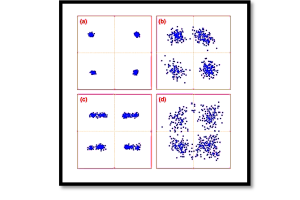
The Costas Loop in PSK Demodulation: A Detailed Overview
Introduction to PSK Demodulation and Carrier Recovery
Phase Shift Keying (PSK) is a widely-used digital modulation technique in communication systems where information is encoded in the phase of a carrier signal. To demodulate a PSK signal accurately at the receiver, the phase and frequency of the carrier signal must be perfectly matched with the original transmitted signal. This synchronization process is non-trivial, especially in real-world scenarios where:
- The receiver does not have access to the original unmodulated carrier.
- Noise and other distortions can disrupt synchronization.
The Costas Loop provides an elegant solution for this by simultaneously recovering the carrier and demodulating the data signal.

What is the Costas Loop?
The Costas Loop is a feedback control system designed to recover the phase and frequency of the modulated carrier signal while extracting the original data. It is particularly effective for coherent demodulation of Binary Phase Shift Keying (BPSK) and Quadrature Phase Shift Keying (QPSK) signals. The loop leverages a combination of phase detection, feedback, and a voltage-controlled oscillator (VCO) to achieve carrier synchronization.
The Costas Loop consists of the following key components:
- Input Signal: The received signal, A(t)cos(ωct+θc), is the modulated carrier where:
- A(t): Amplitude (contains the binary data, e.g., ±1).
- ωc: Carrier frequency.
- θc: Unknown phase offset due to transmission.
- Voltage-Controlled Oscillator (VCO): Generates a local reference carrier signal, cos(ωct+θv), where θv is the VCO’s current phase. The loop adjusts θv to match θc.
- Mixing (Multipliers): Two multipliers mix the received signal with:
- cos(ωct+θv) for the In-Phase (I) path.
- sin(ωct+θv) for the Quadrature (Q) path.
- Low-Pass Filters (LPFs): Remove the high-frequency components from the mixed signals to retain only the baseband components.
- Phase Error Detector: Combines the I and Q signals to generate a phase error term used to control the VCO.
Costas Loop Operation: Step-by-Step Breakdown
Step 1: Mixing and Path Splitting
The received signal A(t)cos(ωct+θc) is multiplied by two locally generated signals:
- In-Phase Path (I): Multiplied with cos(ωct+θv):

2. Quadrature Path (Q): Multiplied with sin(ωct+θv):

Step 2: Phase Error Detection The I-path and Q-path outputs are combined to compute the phase error:

This phase error term is fed back into the system to control the VCO. When Δθ=0, the error term vanishes, and the system locks onto the correct carrier phase.
Step 3: Adjusting the VCO
The phase error signal controls the VCO, which adjusts θv iteratively to minimize Δθ. The VCO’s output evolves over time to align its phase θv with the received signal’s phase θc.
Mathematical Insights into the Costas Loop
· In-Phase Path: After synchronization (Δθ=0: I-path Output: A(t), which corresponds to the demodulated binary data.
· Quadrature Path: After synchronization (Δθ=0): Q-path Output: 0, indicating no residual phase error.
· Stability of the Loop: The Costas Loop is stable when Δθ converges to zero, ensuring:
- Accurate recovery of the carrier phase and frequency.
- Reliable demodulation of the binary data A(t).
Advantages of the Costas Loop
- Simultaneous Demodulation and Carrier Recovery: The loop eliminates the need for a separate carrier recovery circuit, reducing complexity.
- Noise Resilience: The feedback design improves performance in noisy environments.
- Versatility: Applicable to various PSK schemes (e.g., BPSK, QPSK).
- Precision: The loop locks onto the carrier with high accuracy, ensuring minimal phase error.
Practical Considerations and Applications
- Lock Acquisition: Initial phase differences can cause the loop to take longer to converge. Proper loop filter design is critical for quick lock acquisition.
- Noise and Jitter: Noise can disrupt the loop’s performance, especially for higher-order modulation schemes.
- Applications: The Costas Loop is extensively used in satellite communications, radio systems, and other coherent communication systems requiring high reliability.
Take our entry level course (Below) for free using coupon code RAHRF101BLOG
RF Fundamentals, Basic Concepts and Components – RAHRF101
For limited time take an additional 10% off of all our courses using coupon code RFCERT10
Rahsoft RF Certificate and courses
Conclusion
The Costas Loop is a cornerstone in modern PSK demodulation, enabling precise carrier recovery and data demodulation simultaneously. Its iterative feedback mechanism, based on minimizing phase error, ensures robust operation in various scenarios. By combining simplicity, accuracy, and resilience, the Costas Loop has cemented its place as an essential tool in digital communication systems.

Learn more about this topic by taking the complete course ‘Introduction to Modulation in Communication Systems Online Course – RAHRF152’. Watch the course videos for more detailed understanding. Also checkout other courses on RF system and IC design on https://rahsoft.com/courses/. Rahsoft also provides a certificate on Radio Frequency. All the courses offer step by step approach.
Tag:Costas loop, demodulation, PSK



